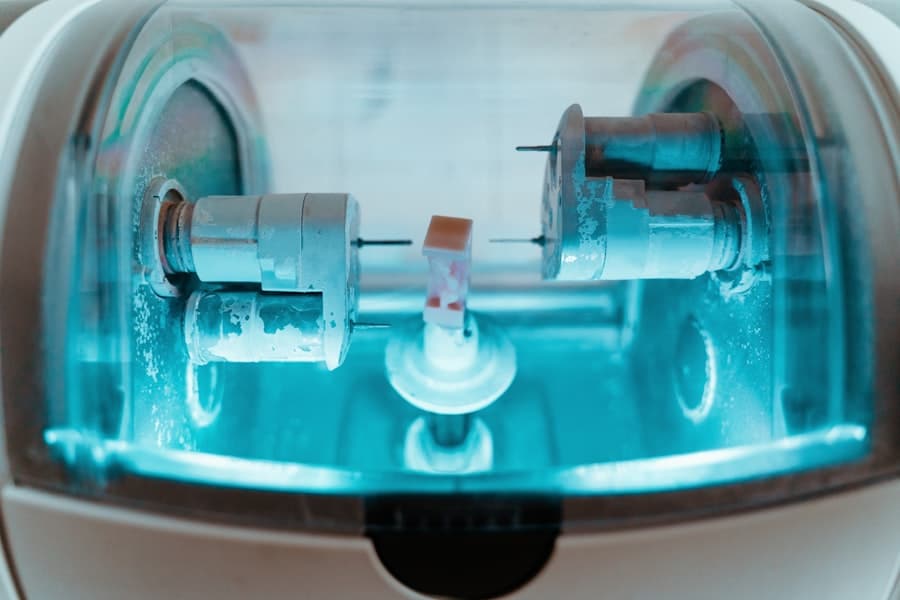Lab-on-a-chip (LOC) technology represents a significant advancement in the field of analytical chemistry and biomedical engineering, encapsulating complex laboratory functions onto a single microchip. This miniaturization allows for the integration of various laboratory processes, such as sample preparation, chemical reactions, and detection, all within a compact device that can be as small as a credit card. The concept of LOC emerged from the need for more efficient, cost-effective, and rapid diagnostic tools that can be utilized in diverse settings, particularly in point-of-care (POC) environments.
By leveraging microfluidics—the manipulation of fluids at the microscale—LOC devices can perform multiple analyses simultaneously, thereby enhancing throughput and reducing the time required for results. The development of lab-on-a-chip technology has been fueled by advancements in materials science, nanotechnology, and microfabrication techniques. These innovations have enabled the creation of intricate channel networks and reaction chambers on chips, allowing for precise control over fluid dynamics and chemical interactions.
As a result, LOC devices can facilitate a wide range of applications, from medical diagnostics to environmental monitoring and food safety testing. The versatility of lab-on-a-chip technology is underscored by its ability to integrate various detection methods, including optical, electrochemical, and mass spectrometric techniques, making it a powerful tool for researchers and clinicians alike.
Key Takeaways
- Lab-on-a-Chip technology miniaturizes laboratory functions onto a single chip, revolutionizing diagnostic testing.
- The technology offers advantages for point-of-care testing, including rapid results, minimal sample requirement, and portability.
- Current challenges and limitations include standardization, integration with existing healthcare systems, and cost considerations.
- Emerging technologies and innovations in Lab-on-a-Chip include improved sensitivity, multiplexing, and automation.
- Integration with digital health and telemedicine can enable remote monitoring and real-time data analysis, enhancing patient care.
Advantages of Lab-on-a-Chip for Point-of-Care Testing
One of the most compelling advantages of lab-on-a-chip technology is its potential to revolutionize point-of-care testing (POCT). Traditional diagnostic methods often require centralized laboratory facilities, which can lead to delays in obtaining results and hinder timely clinical decision-making. In contrast, LOC devices can be deployed directly at the site of patient care—be it a hospital bedside, a remote clinic, or even a patient’s home—enabling immediate access to diagnostic information.
This rapid turnaround time is particularly crucial in emergency situations where timely interventions can significantly impact patient outcomes. Moreover, lab-on-a-chip devices are designed to be user-friendly and require minimal training to operate. Many LOC systems utilize simple sample input methods and provide results through intuitive interfaces, making them accessible to healthcare providers with varying levels of technical expertise.
This ease of use is complemented by the potential for automation in sample processing and analysis, which reduces the risk of human error and enhances the reliability of results.
Current Challenges and Limitations

Despite the numerous advantages offered by lab-on-a-chip technology, several challenges and limitations persist that hinder its widespread adoption in clinical practice. One significant hurdle is the complexity of designing LOC devices that can accommodate a diverse range of assays while maintaining high sensitivity and specificity. The miniaturization of components can lead to issues such as fluidic resistance and sample contamination, which may compromise the accuracy of test results.
Furthermore, developing standardized protocols for various applications remains a challenge, as variations in sample types and assay conditions can affect performance. Another critical limitation is the regulatory landscape surrounding lab-on-a-chip devices. The approval process for medical diagnostics can be lengthy and complex, often requiring extensive validation studies to demonstrate safety and efficacy.
This regulatory burden can slow down the commercialization of innovative LOC technologies, deterring investment and research in this promising field. Additionally, there is a need for robust quality control measures to ensure that LOC devices consistently deliver reliable results across different settings and populations.
Emerging Technologies and Innovations
As research in lab-on-a-chip technology continues to evolve, several emerging innovations are poised to address existing challenges and expand the capabilities of LOC devices. One notable trend is the integration of biosensors into lab-on-a-chip systems. These biosensors can detect specific biomolecules with high sensitivity and selectivity, enabling the development of highly targeted assays for various diseases.
For instance, researchers are exploring the use of nanomaterials to enhance signal amplification in biosensors, which could lead to earlier detection of conditions such as cancer or infectious diseases. Another exciting area of development is the incorporation of artificial intelligence (AI) and machine learning algorithms into lab-on-a-chip platforms. By analyzing large datasets generated from LOC devices, AI can help identify patterns and correlations that may not be immediately apparent to human operators.
This capability could enhance diagnostic accuracy and facilitate personalized medicine approaches by tailoring treatment strategies based on individual patient profiles. Furthermore, advancements in microfabrication techniques are enabling the creation of more complex chip architectures that can perform multiple assays simultaneously, paving the way for multiplexed testing capabilities.
Integration with Digital Health and Telemedicine
The convergence of lab-on-a-chip technology with digital health solutions and telemedicine represents a transformative shift in how healthcare is delivered. As telemedicine gains traction, particularly in response to global health crises like the COVID-19 pandemic, the ability to conduct rapid diagnostics at home or in remote locations becomes increasingly valuable. Lab-on-a-chip devices can be integrated with mobile health applications that allow patients to monitor their health status in real-time and share results with healthcare providers seamlessly.
This integration not only enhances patient engagement but also facilitates remote monitoring and management of chronic conditions. For example, patients with diabetes could use LOC devices to perform blood glucose tests at home and transmit data directly to their healthcare team for timely adjustments in treatment plans. Additionally, the combination of lab-on-a-chip technology with wearable devices could enable continuous health monitoring, providing clinicians with comprehensive insights into patient health trends over time.
Regulatory and Commercialization Considerations

Navigating the regulatory landscape is a critical aspect of bringing lab-on-a-chip technologies to market. Regulatory bodies such as the U.S. Food and Drug Administration (FDA) have established guidelines for medical devices that must be adhered to during the development process.
These guidelines often require extensive preclinical and clinical testing to demonstrate safety and efficacy before a product can receive approval for commercial use. As such, developers must engage in thorough planning and documentation throughout the design process to ensure compliance with regulatory standards. Commercialization also poses challenges for lab-on-a-chip technologies due to market competition and pricing pressures.
Developers must not only demonstrate the clinical utility of their products but also establish a clear value proposition that differentiates their offerings from existing diagnostic solutions. Collaborations with healthcare providers, research institutions, and industry partners can facilitate market entry by providing access to resources, expertise, and distribution channels. Additionally, securing funding through grants or venture capital investments is often essential for advancing product development from concept to commercialization.
Future Applications and Impact on Healthcare
The future applications of lab-on-a-chip technology are vast and hold significant potential for transforming healthcare delivery across various domains. In infectious disease management, LOC devices could enable rapid screening for pathogens at points of entry such as airports or border crossings, facilitating early containment measures during outbreaks. Similarly, personalized medicine approaches could benefit from LOC technologies that allow for real-time monitoring of biomarkers associated with treatment response, enabling clinicians to tailor therapies based on individual patient needs.
Beyond diagnostics, lab-on-a-chip technology has implications for drug development and therapeutic monitoring. By utilizing LOC platforms for high-throughput screening of drug candidates or assessing drug interactions at the microscale, researchers can accelerate the discovery process while minimizing resource expenditure. Furthermore, LOC devices could play a role in vaccine development by enabling rapid assessment of immune responses in clinical trials.
Conclusion and Outlook
As lab-on-a-chip technology continues to advance, its integration into healthcare systems promises to enhance diagnostic capabilities and improve patient outcomes significantly. The ongoing development of innovative materials, biosensors, and AI-driven analytics will likely expand the range of applications for LOC devices while addressing current limitations related to accuracy and regulatory compliance. The synergy between lab-on-a-chip technology and digital health solutions will further empower patients and healthcare providers alike by facilitating timely access to critical health information.
Looking ahead, it is essential for stakeholders—including researchers, clinicians, regulatory bodies, and industry leaders—to collaborate in overcoming existing challenges while fostering an environment conducive to innovation. By doing so, lab-on-a-chip technology can realize its full potential as a transformative force in healthcare delivery, ultimately leading to more efficient diagnostics, personalized treatment strategies, and improved public health outcomes on a global scale.
com, Tesla refutes Elon Musk’s timeline on full self-driving technology, highlighting the challenges and complexities of developing autonomous vehicles. This article provides valuable insights into the future of technology and innovation, much like the advancements discussed in “The Future of Lab-on-a-Chip for Point-of-Care Testing.” Both articles shed light on the potential of cutting-edge technologies to revolutionize various industries and improve the quality of life for individuals worldwide. Read more here.
FAQs
What is Lab-on-a-Chip technology?
Lab-on-a-Chip technology is a miniaturized device that integrates one or several laboratory functions on a single chip. It allows for the automation and integration of multiple laboratory tasks, such as sample preparation, analysis, and detection, on a small and portable platform.
What is Point-of-Care Testing (POCT)?
Point-of-Care Testing (POCT) refers to medical diagnostic testing performed at or near the site of patient care. It provides rapid results, allowing for immediate clinical decision-making and treatment.
What are the advantages of Lab-on-a-Chip for Point-of-Care Testing?
Lab-on-a-Chip technology for Point-of-Care Testing offers several advantages, including rapid results, reduced sample and reagent volumes, portability, and the potential for decentralized testing in remote or resource-limited settings.
What are the potential applications of Lab-on-a-Chip for Point-of-Care Testing?
Lab-on-a-Chip technology has the potential to be used for a wide range of applications, including infectious disease diagnostics, monitoring of chronic diseases, detection of biomarkers, environmental monitoring, and food safety testing.
What are the current challenges in the development of Lab-on-a-Chip for Point-of-Care Testing?
Challenges in the development of Lab-on-a-Chip for Point-of-Care Testing include the need for standardization, regulatory approval, integration with existing healthcare systems, and the development of cost-effective and user-friendly devices.

